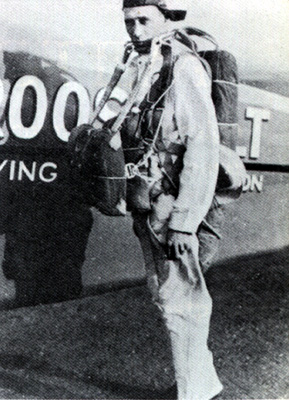Featured Exhibits
Sign up for the Newsletter
Advertise on ParachuteHistory.com
Disclaimer
Privacy Policy
About
Joe Crane
First Jump: March 5, 1923Crane joined the Army Air Service and made about 15 jumps while in the service for 3 years, 1921-1924. One jump including exiting from 20,300 feet.
 After leaving the service Crane joined The Burns Flying Circus.
Crane joined the Burns Circus without knowing that the previous jumper was killed during a stunt he would be expected to perform. His barnstorming days lasted from 1925 to 1929.
After leaving the service Crane joined The Burns Flying Circus.
Crane joined the Burns Circus without knowing that the previous jumper was killed during a stunt he would be expected to perform. His barnstorming days lasted from 1925 to 1929.
Crane learned the stunt and thrilled crowds by making them believe he was going to die. Then at the last possible moment he would pull his ripcord and live.
As Crane's reputation expanded he was billed as "The World's Marvel Parachute Jumper" or as "Jumping Jack" Crane.
On July 19, 1925, Crane made a delay of 2,250 feet, a record then, to disprove the theory that a man would lose consciousness in freefall. Later the record was surpassed by a delay of 3,500 feet. National attention and recoginition followed Crane as he made these milestones.
Spot Landing Competitions were all the rage in the 1920's. Crane, jumping an unsteerable parachute, mangaed to win a large number of these competitions by slipping his parachute as neccessary. These accuracy meets could be won by landing 50 to 100 feet from the target.
By 1930, Crane turned his attention to making parachuting safer and making jumpers more responsible for their actions. Crane's efforts resulted in legislation for mandatory use of reserve parachute, limits on wind speed and rules concerning new parachute jumpers.
Crane organized the National Parachute Jumpers Association (NPJA). The NPJA helped jumpers receive proper pay at air shows and not be victimized by operators.
In 1933, NAA started issuing parachute licenses. Crane was on the Board of Parachute Experts that established guidelines for the licenses. Parachutists were becoming an offical member of the aviation community.
After Word War II ended, many military riggers joined the ranks of parachutists. NPJA became National Parachute Jumpers and Riggers (NPJR). Legislation was introduced to certify riggers and what type of parachutes they could pack.
In 1947, NPJR became affliated with NAA and was the sole US representative to FAI. C-license #1 was issued to Joe Crane.
The next year Crane received the very first Leo Stevens award.
In the 1950's Crane worked on competition rules. The first parchuting World Meet in 1956 enhanced participation in parachuting.
NPJR became the Parachute Club of America (PCA) in 1957. Crane was the first President of PCA and later became FAI President. Crane's tenure as President lasted until 1963, when he retired.
Crane established Basic Safety Regulations and Area Safety Officers to help the sport grow.
Crane died Feb 25 1968 after a long illness.
Crane recieved the first USPA Achievement Award, posthumously on June 27, 1971.
[Products] | [Services]
[Join Our Mailing List] | [Advertise on ParachuteHistory.com]
[ ]
[Disclaimer] | [Privacy Policy] | [About]